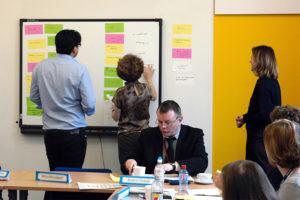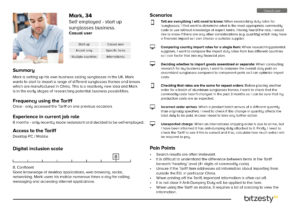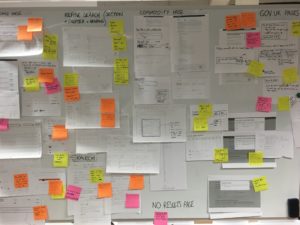Back in 2012 we built the Trade Tariff digital service for Her Majesty’s Revenue and Customs (HMRC). The service allows people to look up key information on importing and exporting different types of goods.
HMRC recently asked us to run a “rediscovery” for the service. We carried out user research and testing to identify how the service could be updated to better meet users’ changing needs.
In this post I’ll look at the different types of research we carried out to build a full picture of what users needed, and how we used this to build and test prototypes for an improved service.
Workshops & observation of expert users
We started by running two workshops with expert users so we could understand what they thought of the current Trade Tariff digital service.
Our first workshop was with members of the Joint Customs Consultative Committee (JCCC). The JCCC is an HMRC-sponsored group of over 20 organisations who are major importers or exporters.
Our second workshop was with HMRC’s Trade Team who are heavy users of the Trade Tariff, and who also deal with customer queries about the digital service. We held the workshop at HMRC offices, following which we conducted contextual enquiry where we interviewed the users while observing them doing their work.
The workshops and the contextual enquiry gave us some great insight into what expert users need from the service. For example, they told us they wanted to see more detailed information upfront, rather than having to drill down to see it.
The users from HMRC’s Trade Team were also able to highlight the most frequent customer queries or problems they dealt with. For example, some business users were finding it difficult to search for the item they wanted to import or export. When they did find the right item, some were passing the wrong pieces of information onto HMRC when processing their import/export.
The workshops helped to identify some existing “pain points” for users. It gave us a good overview of user needs and helped to define the areas we needed to investigate and research further.
Remote testing the existing service with novice users
We carried out remote user testing with people who had never used the Trade Tariff service before. Remote testing is a great way to quickly carry out user research with a large number of people.
We gave the users three tasks to complete on the existing Trade Tariff digital service, and recorded their screen and voice as they completed the tasks.
For example, one of the tasks was to use the service to check the tax, duty and licences that apply when importing 200 bottles of red wine into the UK from California. We found that many of the users struggled to find the information they were looking for. The rules and data surrounding exporting and importing can be complex. In some cases users were actually in the right place and looking at the right information, but they hadn’t realised it.
The results gave us some great insight into what was and what wasn’t working for users. It was also fascinating to see the different journeys users took through the service to achieve the same goal.
Building user personas
Interestingly, the results of our research with expert users didn’t line up with the results of our research with novice users.
Although the two user groups had the same end goal, they had a very different approach to using the service and wanted different levels of detail at different points in their journey.
During our workshops with expert users, they told us that they wanted to see more detailed information upfront when they were searching for a product. However, watching the novice users complete their search tasks, told us they needed the opposite. They needed less information upfront and for the service to be broken down into a simplified, step-by-step process.
These kind of findings highlight why it’s important to conduct research with a wide range of users. It helps you understand the similarities and differences in what your users want from the service and their different use cases. However well you feel you know your users and what they need, it’s always worth carrying out user research – the results may surprise you!
We used our research to validate and refine our Trade Tariff user personas.
A persona is a fictional character who represents one of your user groups. It sets out their background, goals, needs, and behaviour. For example, our Mark persona represented the group of users who own a small business and use the Trade Tariff service on an irregular basis.
We always give our personas a name and a photo – it helps to bring the user to life, both for us and our clients. It’s easier to think about what Mark needs, rather than the needs of an anonymous group of small business owners.
Guerrilla testing a low-fidelity prototype
After we’d completed our initial user research, the Bit Zesty team got together for a brainstorming session to review what we’d learnt and develop some ideas.
We had pages and pages of ideas! We whittled down our list, based on what the research told us was most important to users.
We came out of the session with a clear sense of the changes we needed to make to the digital service. We used this to quickly pull together a basic working prototype of a revised Trade Tariff tool.
We took the low-fidelity prototype to the streets (well, coffee shops) for some guerrilla user testing. We asked people to work through the process of finding the tax and duties payable when importing wine. This was the same task we’d asked our remote testers to complete, so we were able to compare the user experience before and after our changes.
This informal user research allowed us to quickly test our ideas and theories. Were we on the right track? Had the changes had a positive effect on usability?
High-fidelity prototype and more user research
We used the results of our low-fidelity prototype testing to help us build a high-fidelity prototype. If one of our changes had made a positive difference to the user experience, we kept and enhanced it. If it hadn’t, we tried a different approach.
We tested the high-fidelity prototype with users from HMRC’s Trade Team face-to-face. We asked them to work through the same tasks as we had before so we could compare results. As they worked, we asked in-depth questions so we could better understand the thinking behind their actions, how they were working, and see how the prototype fitted in with the way they worked.
After each testing session, we made incremental improvements to the prototype, before testing it with the next person.
We also shared the high-fidelity prototype with other users at HMRC so more people could test it and give feedback.
What next?
Thanks to several rounds of user research, we’ve developed a digital service that will be simpler for novice users, and more efficient for expert users.
Although the changes we made so far will benefit novice users the most, we hope this will lead to fewer queries received by the HMRC’s Trade Team. However, in future, we’ll be looking back at our user personas and research findings to make changes that benefit the different user groups.
The new Trade Tariff tool is due to go live in next few weeks. We’ll be monitoring its use and look forward to finding out what users think. Please read How to create more realistic prototypes for user research by faking changes to learn more about our user testing of the Trade Tariff tool.













